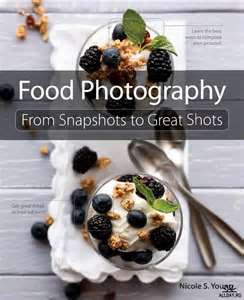Ordinarily, I write almost every word in each blog post. This time is different. Here’s the whole first paragraph from the back cover of Food Photography: From Snapshots to Great Shots:
“Are you a ‘foodie’ looking to take eye-caching photos of our culinary concoctions? Do you have a food blog that you’d like to enhance with better visuals? Do you want to create photos that conjure up the flavors of your favorite foods but lack the photographic technique to make it happen? Then this book is for you!”
It’s all true. I have to answer “yes” to all those questions, especially the photographic techniques. I open up Photoshop, look at all the menus, all the sliders, all the options, all the filters to do incredible things, and I just feel like I’m being waterboarded. I freeze. I panic. I don’t get anywhere.
Well, I did not get anywhere, but now I can. Food Photography is an amazing book. In under 300 pages, you get a boot camp experience that has you armed and ready both to take great food photos and then to use the digital tools available to make them even better. The book has an ideal road path in seven chapters:
- Photography Fundamentals
- Photography Equipment
- Lighting
- Styling and Props
- Framing and Composition
- Processing Images with Adobe Photoshop
- Behind the Scenes [8 sample photo shoots with detailed explanations]
Each chapter begins very cleverly with one or two “Pouring Over the Picture” segments, which are two pages color spreads of a food shot — replete with detailed notes about the camera, exposure, focusing point, lighting, props, and adornments. Right off the bat, you are taught not just to look at a picture, as a whole, but to look at all the physical elements that comprise a wonderful picture.
No, you won’t be a qualified CSI expert after you read this book, but it’s going to change how you look at any picture. It’s the details — or the lack of them in areas when you use soft focus or narrow depth of field. It’s the lighting. And it’s those shadows that literally add dimension and character.
The chapter on equipment is important because it can take away both the mystery and the sticker shock. You don’t have to spend a small fortune to get started, but you do have to choose wisely. Part of your budget does have to go for lighting. The lighting chapter has photos paired with a “top down overhead” diagram of the lighting tools used to make the shot so natural. Lighting means not just lights but also reflecting and absorbing surfaces that affect the size and locations of lighting hot spots and those critical shadows. The diagrams show that, with modest outlay, you can have a home photo studio that will significantly improve your results.
The composition chapter tells you what you really already know but have not wanted to do: you need to put some thought and planning into your shot before you click. You really do. We can all take snapshots. And they look just like snapshots. It’s so easy. Now, a great food shot? That means you need a few lessons in angle, placement of the key spot on your camera screen, and how to add little pieces — a fork, some herbs, a soft defused glass in the background — that suddenly convert a picture into art. The lessons here are easily learned and really quickly applied. Just a moment’s planning before you shoot will make all the difference.
The Photoshop chapter here is perhaps the best summary I have ever read. It’s widely recognized that Photoshop is the best photo editing software available. It’s also widely commented that it is a beast to learn In fact, professionals will tell you that they have their “favorite tools and techniques” which they use over and over — while maybe 90% of the features in Photoshop are just not in their repertoire.
In this Photoshop chapter, you can basic lessons in the features and techniques you simply HAVE to know and will want to use. With these alone, you can do good editing and you’ll now have the foundation you need to explore Photoshop more and find those personal features that you treasure. The point is, if you have a photo and it needs work, this chapter can probably get you through it. You won’t sit there stymied or mystified or wishing the first digit of your IQ was a “2.” A “1” will be just fine with Food Photography.
If you are that “foodie” or “blogger” who wants assistance, then this book is the one I suggest you begin with. You’ll enjoy it, and return often to reinforce the wealth of information and tips it provides.

